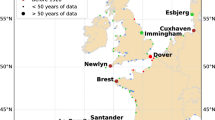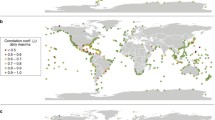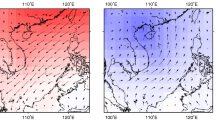Abstract
Storm surges are one of the major hazards in coastal regions; positive surge events are added to tidal levels, increasing the risk of coastal flooding by extreme water levels. In this study, changes in the frequency (occurrence rate per year), intensity (magnitude of the extremes) and duration of extreme storm surge events from 1948 to 2013 are investigated using a non-stationary statistical model. To fully model extremes, the time-dependent statistical model combines the Generalized Pareto Distribution (GPD) for studying exceedances over the threshold, and the non-homogeneous Poisson (P) process for studying the occurrence rate of these exceedances. Long-term trends and the association between storm surges and the North Atlantic Oscillation (NAO) are represented in the model by allowing the parameters in the GPD–P model to be time-dependent. Different spatial patterns in the three analysed properties of storm surges are found in the Atlantic region and the Mediterranean Sea. The up to now uncharted regional patterns of storm surge duration show completely different values between the Atlantic and the Mediterranean regions, being the duration of storms surges in the Atlantic two times longer than the duration in the Mediterranean. For the last half century, we detect positive and negative spatial trends in terms of intensity of storm surge but only significant decreasing rates, of around 2 %, in the number of extreme events per year. Regarding duration, we find positive trends in certain Mediterranean areas, with durations of extreme events increasing at a rate of 0.5–1.5 h/year. Values for the 50-year return level are also estimated, showing a large spatial variability with relatively higher values along the coast. A clear sensitivity of extreme storm surges to negative NAO index is detected, specifically in the western Mediterranean basin. Results show that negative NAO phases lead to an increase in the number of extreme events and also in their intensity.







Similar content being viewed by others
References
Arns A, Wahl T, Haigh I, Jensen J, Pattiaratchi C (2013) Estimating extreme water level probabilities: a comparison of the direct methods and recommendations for best practise. Coast Eng 81:51–66. doi:10.1016/j.coastaleng.2013.07.003, http://www.sciencedirect.com/science/article/pii/S0378383913001270
Arns A, Wahl T, Haigh ID, Jensen J (2015) Determining return water levels at ungauged coastal sites: a case study for northern Germany. Ocean Dyn 65(4):539–554. doi:10.1007/s10236-015-0814-1, http://link.springer.com/10.1007/s10236-015-0814-1
Bartholy J, Pongrácz R, Pattantyús-Ábrahám M (2009) Analyzing the genesis, intensity, and tracks of western Mediterranean cyclones. Theor Appl Climatol 96(1–2):133–144. doi:10.1007/s00704-008-0082-9
Baxter PJ (2005) The east coast Big Flood, 31 January–1 February 1953: a summary of the human disaster. Philos Trans Ser A Math Phys Eng Sci 363(1831):1293–1312. doi:10.1098/rsta.2005.1569
Bernardara P, Andreewsky M, Benoit M (2011) Application of regional frequency analysis to the estimation of extreme storm surges. J Geophys Res Oceans 116(C2):C02008. doi:10.1029/2010JC006229
Bernier NB, Thompson KR (2006) Predicting the frequency of storm surges and extreme sea levels in the northwest Atlantic. J Geophys Res Oceans 111(C10):C10009. doi:10.1029/2005JC003168
Butler A, Heffernan JE, Tawn Ja, Flather Ra, Horsburgh KJ (2007) Extreme value analysis of decadal variations in storm surge elevations. J Mar Syst 67(1–2):189–200. doi:10.1016/j.jmarsys.2006.10.006
Calafat FM, Chambers DP, Tsimplis MN (2012) Mechanisms of decadal sea level variability in the eastern North Atlantic and the Mediterranean Sea. J Geophys Res Oceans 117(C9):C09022. doi:10.1029/2012JC008285
Cavicchia L, von Storch H, Gualdi S (2014) Mediterranean tropical-like cyclones in present and future climate. J Clim 27(19):7493–7501. doi:10.1175/JCLI-D-14-00339.1
Church J, Clark P, Cazenave A, Gregory J, Jevrejeva S, Levermann A, Merrifield M, Milne G, Nerem R, Nunn P, Payne A, Pfeffer W, Stammer D, Unnikrishnan A (2013) Sea level change. In: Climate Change 2013: The Physical Science Basis. Contribution of Working Group I to the Fifth Assessment Report of the Intergovernmental Panel on Climate Change, pp 1137–1216
Cid A, Castanedo S, Abascal AJ, Menéndez M, Medina R (2014) A high resolution hindcast of the meteorological sea level component for Southern Europe: the GOS dataset. Clim Dyn 43(7–8):1–18. doi:10.1007/s00382-013-2041-0
Coles S, Bawa J, Trenner L, Dorazio P (2001) An introduction to statistical modeling of extreme values, vol 208. Springer Series in Statistics, London
Gomis D, Ruiz S, Sotillo MG, Álvarez Fanjul E, Terradas J (2008) Low frequency Mediterranean sea level variability: the contribution of atmospheric pressure and wind. Glob Planet Change 63(2–3):215–229. doi:10.1016/j.gloplacha.2008.06.005
Gräwe U, Burchard H (2012) Storm surges in the Western Baltic Sea: the present and a possible future. Clim Dyn 39(1–2):165–183. doi:10.1007/s00382-011-1185-z
Haidvogel DB, Arango HG, Hedstrom K, Beckmann A, Malanotte-Rizzoli P, Shchepetkin AF (2000) Model evaluation experiments in the North Atlantic Basin: simulations in nonlinear terrain-following coordinates. Dyn Atmos Oceans 32(3–4):239–281. doi:10.1016/S0377-0265(00)00049-X
Haidvogel DB, Arango H, Budgell WP, Cornuelle BD, Curchitser E, Di Lorenzo E, Fennel K, Geyer WR, Hermann AJ, Lanerolle L, Levin J, McWilliams JC, Miller AJ, Moore AM, Powell TM, Shchepetkin AF, Sherwood CR, Signell RP, Warner JC, Wilkin J (2008) Ocean forecasting in terrain-following coordinates: formulation and skill assessment of the Regional Ocean Modeling System. J Comput Phys 227(7):3595–3624. doi:10.1016/j.jcp.2007.06.016
Haigh I, Nicholls R, Wells N (2010) Assessing changes in extreme sea levels: application to the English channel, 1900–2006. Cont Shelf Res 30(9):1042–1055. doi:10.1016/j.csr.2010.02.002
Haigh ID, Wijeratne EMS, MacPherson LR, Pattiaratchi CB, Mason MS, Crompton RP, George S (2014) Estimating present day extreme water level exceedance probabilities around the coastline of Australia: tides, extra-tropical storm surges and mean sea level. Clim Dyn 42:121–138. doi:10.1007/s00382-012-1652-1
Hallegatte S, Ranger N, Mestre O, Dumas P, Corfee-Morlot J, Herweijer C, Wood RM (2011) Assessing climate change impacts, sea level rise and storm surge risk in port cities: a case study on Copenhagen. Clim Change 104(1):113–137. doi:10.1007/s10584-010-9978-3
Luceño A, Menéndez M, Méndez FJ (2006) The effect of temporal dependence on the estimation of the frequency of extreme ocean climate events. Proc R Soc A Math Phys Eng Sci 462(2070):1683–1697. doi:10.1098/rspa.2005.1652
Marcos M, Tsimplis MN, Shaw AGP (2009) Sea level extremes in southern Europe. J Geophys Res Oceans 114(C1):1–16. doi:10.1029/2008JC004912
Marcos M, Jordà G, Gomis D, Bn Pérez (2011) Changes in storm surges in southern Europe from a regional model under climate change scenarios. Glob Planet Change 77(3–4):116–128. doi:10.1016/j.gloplacha.2011.04.002
Méndez FJ, Menéndez M, Luceño A, Losada IJ (2006) Estimation of the long-term variability of extreme significant wave height using a time-dependent Peak Over Threshold (POT) model. J Geophys Res Oceans 111(C7):C07,024. doi:10.1029/2005JC003344
Méndez FJ, Menéndez M, Luceño A, Losada IJ (2007) Analyzing monthly extreme sea levels with a time-dependent GEV model. J Atmos Ocean Technol 24(5):894–911. doi:10.1175/JTECH2009.1
Menéndez M, Woodworth PL (2010) Changes in extreme high water levels based on a quasi-global tide-gauge data set. J Geophys Res Oceans 115(C10):1–15. doi:10.1029/2009JC005997
Menéndez M, Méndez FJ, Losada IJ, Graham NE (2008) Variability of extreme wave heights in the northeast Pacific Ocean based on buoy measurements. Geophys Res Lett 35(22):L22,607. doi:10.1029/2008GL035394
Menendez M, Mendez FJ, Losada IJ (2009) Forecasting seasonal to interannual variability in extreme sea levels. ICES J Mar Sci 66(7):1490–1496. doi:10.1093/icesjms/fsp095
Menendez M, García-Díez M, Fita L, Fernández J, Méndez FJ, Gutiérrez JM (2014) High-resolution sea wind hindcasts over the Mediterranean area. Clim Dyn 42(7–8):1857–1872. doi:10.1007/s00382-013-1912-8
Ma Merrifield, Genz AS, Kontoes CP, Marra JJ (2013) Annual maximum water levels from tide gauges: contributing factors and geographic patterns. J Geophys Res Oceans 118(5):2535–2546. doi:10.1002/jgrc.20173
Mudersbach C, Jensen J (2010) Nonstationary extreme value analysis of annual maximum water levels for designing coastal structures on the German North Sea coastline. J Flood Risk Manag 3(1):52–62. doi10.1111/j.1753-318X.2009.01054.x, http://doi.wiley.com/10.1111/j.1753-318X.2009.01054.x
Raicich F (2003) Recent evolution of sea-level extremes at Trieste (Northern Adriatic). Cont Shelf Res 23(3–4):225–235. doi:10.1016/S0278-4343(02)00224-8
Serafin KA, Ruggiero P (2014) Simulating extreme total water levels using a time-dependent, extreme value approach. J Geophys Res Oceans 119(9):6305–6329. doi10.1002/2014JC010093, http://doi.wiley.com/10.1002/2014JC010093
Shchepetkin AF, McWilliams JC (2005) The regional oceanic modeling system (ROMS): a split-explicit, free-surface, topography-following-coordinate oceanic model. Ocean Model 9(4):347–404. doi:10.1016/j.ocemod.2004.08.002
Storch H, Woth K (2008) Storm surges: perspectives and options. Sustain Sci 3(1):33–43. doi:10.1007/s11625-008-0044-2
Tebaldi C, Strauss BH, Zervas CE (2012) Modelling sea level rise impacts on storm surges along US coasts. Environ Res Lett 7(1):014,032. doi:10.1088/1748-9326/7/1/014032
Trigo IF, Davies TD, Bigg GR (1999) Objective climatology of cyclones in the Mediterranean region. J Clim 12(6):1685–1696. doi:10.1175/1520-0442(1999)012<1685:OCOCIT>2.0.CO;2
Tsimplis M (1997) Extreme sea-level distribution and return periods in the Aegean and Ionian Seas. Estuar Coast Shelf Sci 44(1):79–89. doi:10.1006/ecss.1996.0126
Wahl T, Chambers DP (2015) Evidence for multidecadal variability in US extreme sea level records. J Geophys Res Oceans 120(3):1527–1544. doi10.1002/2014JC010443, http://doi.wiley.com/10.1002/2014JC010443
Wakelin SL, Woodworth P, Flather RA, Williams JA (2003) Sea-level dependence on the NAO over the NW European Continental Shelf. Geophys Res Lett 30(7):1403. doi10.1029/2003GL017041, http://doi.wiley.com/10.1029/2003GL017041
Woodworth PL, Blackman DL (2004) Evidence for systematic changes in extreme high waters since the mid-1970s. J Clim 17(6):1190–1197. doi:10.1002/joc.761
Woodworth PL, Ra Flather, Ja Williams, Wakelin SL, Jevrejeva S (2007) The dependence of UK extreme sea levels and storm surges on the North Atlantic Oscillation. Cont Shelf Res 27(7):935–946. doi:10.1016/j.csr.2006.12.007
Woolf D, Shaw A, Tsimplis M (2003) The influence of the North Atlantic Oscillation on sea-level variability in the North Atlantic region. doi:10.1080/10236730310001633803
Yan Z, Tsimplis MN, Woolf D (2004) Analysis of the relationship between the North Atlantic oscillation and sea-level changes in northwest Europe. Int J Climatol 24(6):743–758. doi:10.1002/joc.1035
Acknowledgments
The authors thank Puertos del Estado (Spanish Ministry of Public Works) for providing the tide gauge records. This work has been partially funded by the Spanish Ministry of Economy and Competitiveness under the research project PLVMA (TRA2011-28900) and the FP7 European project CoCoNet (287844). We also thank the reviewer Dr. Ivan Haigh and an anonymous referee for their valuable comments and suggestions to improve the quality of this paper.
Author information
Authors and Affiliations
Corresponding author
Rights and permissions
About this article
Cite this article
Cid, A., Menéndez, M., Castanedo, S. et al. Long-term changes in the frequency, intensity and duration of extreme storm surge events in southern Europe. Clim Dyn 46, 1503–1516 (2016). https://doi.org/10.1007/s00382-015-2659-1
Received:
Accepted:
Published:
Issue Date:
DOI: https://doi.org/10.1007/s00382-015-2659-1




